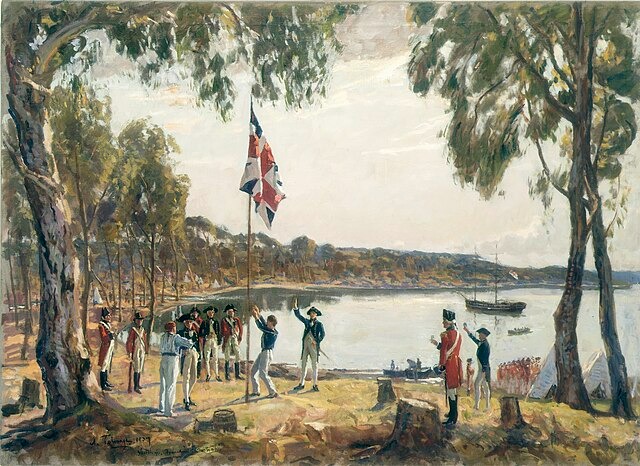Why Australia Day?
In light of the enduring and tedious discussion on the appropriateness and date of “Australia Day”, below are some historical facts of the human evolution on this beloved island continent. All accounts and dates have been researched and compiled by Jason Vlad (with edits and extra commentary by Phillip Fusco) to illuminate the origins and events that led to the day we now celebrate on January 26. We both hope you find it liberating and empowering in your own deliberations
BLOG
Phillip Fusco
1/28/20258 min read


The True History of Australia and its Big Day
In light of the enduring and tedious discussion on the appropriateness and date of “Australia Day”, below are some historical facts of the human evolution on this beloved island continent. All accounts and dates have been researched and compiled by Jason Vlad (with edits and extra commentary by Phillip Fusco) to illuminate the origins and events that led to the day we now celebrate on January 26. We both hope you find it liberating and empowering in your own deliberations.
The Captains
Captain James Cook first arrived on the shores of “New Holland”, or otherwise known in Europe as “Terra Australis” meaning “The Great Southern Land”, on the 29th April 1770. He raised the British flag at Botany Bay (south of modern day Sydney) and claimed the territory for the British Empire.
Four months later, on the 22nd August 1770, Captain James Cook landed on “Possession Island” in the Torres Strait in far North Queensland, raised the British Flag once again and claimed the East Coast of Australia for the British Empire.
All Australians know that we do not celebrate either the 29th of April or the 22nd of August with a National Holiday although these are the very first and second instances that a British explorer landed in Australia, raised a flag and claimed the territory; the 29th April, 1770 and the 22nd August 1770.
Captain Arthur Phillip then arrived with “The First Fleet” some 18 years later which included 11 ships, 1000 passengers (including 700 convicts) in the Botany Bay region on the 18th January 1788. An officer in the First Fleet disembarked to stretch his legs on land outside Botany Bay on the same day; the 18th January 1788.
Captain Phillip found the location not appropriate for settlement so he sent scouts north up the coast for a more suitable location (earlier identified by Captain Cook but kept secret by the British Admiralty). The location was Port Jackson which is today known as modern day Sydney, located in a huge and protected deep sea harbour. On the 26th January 1788 Captain Phillip raised the British flag at Port Jackson claiming the territory for the British Crown, some 8 days after their arrival and landing at Botany Bay.
Interestingly, Commodore La Perouse, the French explorer, landed (or invaded) in what is today called Frenchman’s Beach in La Perouse, Botany Bay two days before Captain Phillip entered Botany Bay, on the 24th January 1788. Commodore La Perouse raised the French flag claiming the territory for France before Captain Phillip claimed the territory once again (after Captain Cook) for the British Empire.
Commodore La Perouse decided to leave 6 weeks later on the 10th March 1788 so as to avoid contention with the British. He had already successfully fought the British in the American Revolution in Hudson Bay New York in 1782 and did not desire another battle.
If you are of the opinion that Australia was intruded upon by the British then although some may claim that this occurred on the 26th January 1788, a far more valid argument could certainly be made for the 18th January 1788 or the 29th April 1770 or the 22nd of August 1770. One can also argue that the French beat the British by two days by landing on the 24th January 1788, although the earliest date is still the arrival and landing of Captain Cook on 29th April 1770.
Why the day is still January 26 is very profound and pertinent and will be explained in more detail later in the article. But before we do it is worth first exploring more deeply the history and origins of foreign intrusion to Australia. You will be greatly surprised.
The Migrations
The earliest evidence to date of a foreign entity landing in Australia are the Negrito people from South East Asia, then the Murrayians (related to the Ainu in Japan), followed by the Carpentarians (a people probably related to the Vedda of Ceylon). They all in succession tried to eliminate or push out each other, until the ice eventually receded in Northern Asia and the land mass known as Australia broke away leaving the then dispersed barbaric like inhabitancy to make their own way, eventually becoming known as the many “Aboriginal” tribes we know of today. These first inhabitants created cultures but nether found the human evolutionary leap to cultivate civilizations. And then the Egyptians came to Australia.
Given that the land mass of Australia appears under the name of “Antoecie” on the famous spherical world map (globe) of the Greek Stoic Philosopher, Crates of Mallos, as well as on the Greek map of Eratosthenese in 150BC & 239BC respectively, It is certain that the maritime civilizations of antiquity circumnavigated the Great Southern Land where they would have had to disembark for supplies up to 3000 years ago.
Around a century ago in 1900AD, some 250 Egyptian hieroglyphs were discovered carved in a rock face close to Gosford, NSW, 100 km’s north of Sydney which date to around 2000BC. They tell the story of a ship wreck, the nuisance of the insects and then the death of their ship’s Royal leader by two snake bites; none of which is hardly surprising!
According to the Cairo Times, in 1982, archaeologists working at Fayum, near the Siwa Oasis (560km south of Cairo), uncovered fossils of kangaroos and other Australian marsupials which were thousands of years old in Egypt. There was also two gold wooden boomerangs discovered by Prof. Howard Carter in the tomb of Tutankhamen in 1922 (from 1325BC). These discoveries reinforce the all but certain probability that ancient civilizations visited Australian shores.
Then there are the Chinese. It is believed that they first landed in Australia around 1430AD. Admiral Zheng He travelled around South East Asia and the Indonesian archipelago spreading Islam (his faith), building mosques and taking “tribute” back to his Emperor (the Ming Dynasty). This is one of the reasons that Indonesia is an Islamic nation today. Unfortunately the Confucian Religion was opposed to such exploration so Chinese voyages of discovery ended soon thereafter and Chinese records of conquest were destroyed. The only reason we know about Admiral Zheng He is because of the records kept of his travels by South East Asian nations. It is inevitable that he landed in Northern Australia but Chinese records were unfortunately purged.
The next explorers who visited Australia were the Portuguese. Cristovao de Mendonca ‘crashed’ his mahogany ship off the southern coast of Australia and had to pull in for boat repairs close to where Warrnambool, Victoria is today, in February 1522. The remains of a Portuguese fort he built to protect his men from the indigenous population and another sunken mahogany ship are a reminder of their visit and length of time spent in the region. It is also believed that they introduced (unintentionally) rats to the region. The Portuguese government did not admit to being there at the time because of the 1494 “Treaty of Tordesillas”, which classified “Australia” as being in Spanish waters. The Pope “divided” the world into two regions so that Spain and Portugal would not argue over who discovered which territory. It is also estimated that there are around 60 Aboriginal words of Portuguese/Latin origin in that region so apart from the building ruins, there appears to have been considerable time spent and contact made between the Portuguese and Indigenous peoples of the area.
In February 1606, Willem Janszoon, the Dutch Navigator, landed in Cape York Peninsula, North Queensland where he hoisted the Dutch flag and named the Great Southern Land “New Holland” for his homeland. In total, 29 Dutch explorers circumnavigated “New Holland” and landed; hoisting their flags as they assessed what is today Western Australia and Tasmania for settlement in the 1600’s, more than 150 years before the British and French. Given the number of Dutch explorers and ships, it’s surprising we did not become a Dutch colony.
In October 1606, the Spanish explorer Luís Vaz de Torres sailed through, and navigated the Torres Strait islands off the coast of Northern Queensland claiming these
territories (which are part of Australia today) for Spain.
Clearly there were in ancient times, many nomadic tribes and Egyptian explorers who settled in Australia, and in more recent centuries, Chinese, Portuguese, Dutch, Spanish, French and British explorers who sailed around Australia and who landed. Some stayed for many years before leaving but only the British chose to stay long term and built a modern civilization on the best worldly wisdom and spiritual enlightenment available.
No back to the conversation surrounding Australia day. The real problem for those that believe that Europeans invaded Australia (let alone other civilizations) is which date did they invade and who invaded who? Was it 60,000BC, 30,000BC or 2,000BC? Or was it sometime in February 1522 (bringing with them rodents), February 1606, October 1606, 29th April 1770, 22nd August 1770, 18 January 1788, 22nd January 1788 or 24th January 1788. Those who wish to change the date we celebrate Australia Day because of the connection with a supposed invasion by foreign explorers or settlers clearly don’t know their history.
The Australians
It is interesting to note that Australia Day was celebrated on different dates in different States from 1901 to 1948. In 1915, Australia Day was celebrated on the 30th July and from 1916 onwards it was celebrated in many parts of Australia on the 28th July.
In 1935 there was an agreement to celebrate Australia Day on the 26th January but it was not strictly adhered to for reasons which varied from State to State. Eventually it was settled to always be the nearest Monday to the 26th January each year in 1946. Finally in 1994, Australia Day was made a public holiday on the 26th
January no matter which day of the week the 26th January fell on.
Lastly, it is also interesting to note that on the 26th of January 1949, the concept of “Australian Nationality” first came into existence through the “Nationality and Citizenship Act 1948”. That was the day we were first allowed to travel with a new passport which was called an “Australian Passport”. Prior to the 26th January 1949, all people in Australia were called British Subjects and they had British Passports.
Therefore the 26th January 1949 is the date that the Australian Passport came into existence. This means that on the 26th January 1949 all those of European descent together with all those of Aboriginal descent in Australia, automatically became Australian citizens under one Nationality for the very first time.
The 26th January 1949 is the day that all the inhabitants of Australia became united under one identity. It is a date that we commemorate annually which unifies all Australians and should not be classified as an “Invasion Day” especially when one considers all the other dates outlined above.
One might ask why is there so much confusion amongst some regarding the significance of the 26th January and its link to an invasion? Some have suggested that it stems from the Bicentennial Celebrations in Sydney on the 26th January 1988 which was televised across Australia and the World. This is where a spectacular re-enactment of Captain Cook’s landing at Botany Bay was performed with a full scale replica of his ship the Endeavour followed by many other “tall ships” (replica ships) and countless actors in British Naval attire.
This may have been quite a theatrical sight to behold but of course the Bicentennial Celebrations in Sydney and all over Australia on the 26th January 1988 were not held on the commemorative date of Captain Cook’s landing and hoisting of the Union Jack on the 29th April 1770 even though this was what was depicted for all to see in Botany Bay and on television, making it deceptive and confusing.
Nor were the Bicentennial Celebrations held on the commemorative date of Captain Phillip’s landing at Botany Bay on the 18th January 1788, but rather on the commemorative date of Captain Phillip’s hoisting a British flag on the 26th January 1788 at Port Jackson (Sydney) and not Botany Bay where the re-enactment took place.
Again deceptive and confusing to the uneducated fuelling an activist uprising that continues to this day.
The Conclusion
Surely the poetic date and triumphant act of 1949, when all Australian’s (from all descendants) united together equal as “Australian citizens” for the very first time is enough cause for celebration and honour. Sure we respect and celebrate different culture but we are one citizen now, one people in a common cause to thrive and survive.
As 1788 was the start of a new modern era and civilization, and 1901 was the birth of a new commonwealth nation, 1949 surely represents our Independence Day (without a war). How good is that!
Final note: If we ever decide to change our political system to a Republic (and I’m not sure yet what’s to be gained by this). Let’s hope it takes place on January 26. Then that makes the “hat-trick” complete.
Let’s be happy Australia and celebrate this momentous day (or we may not be one and free forever).
God Bless Australia


